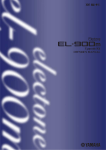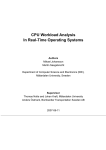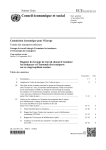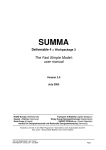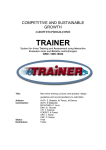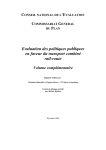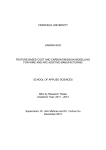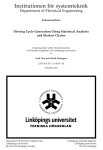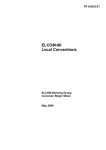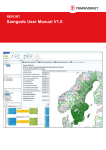Download The Heuristics Intermodal Transport Model – User Guide
Transcript
Rail freight costs Some basic cost estimates for intermodal transport Jonas Flodén March 2011 This report is a part of the project “Strategic modelling of combined transport between road and rail in Sweden” funded by the Swedish Road Administration, Vägverket, and the Swedish Rail Administration, Banverket, through the Swedish Intermodal Transport Research Centre, Sir-C. Jonas Flodén Department of Business Administration School of Business, Economics and Law University of Gothenburg P.O. Box 610 SE 405 30 Göteborg Sweden E-mail: jonas.floden@handels.gu.se http://www.handels.gu.se/fek/logistikgruppen http://www.sir-c.se Telephone: +46-(0)31-786 51 31 3 3 Rail Freight Costs Table of content 1 INTRODUCTION ................................................................................................................................... 5 1.1 1.2 1.3 1.4 1.5 1.6 2 SOME IMPORTANT ASPECTS OF RAIL FREIGHT TRANSPORT CALCULATION ................................................................ 5 COST STRUCTURE ........................................................................................................................................ 5 DEPRECIATION ........................................................................................................................................... 6 OVERHEAD COSTS ....................................................................................................................................... 6 LEVEL OF DETAIL ......................................................................................................................................... 6 EXTERNAL COSTS AND SOCIAL VALUATION ........................................................................................................ 7 TRAIN OPERATIONS ............................................................................................................................. 8 2.1 ROLLING STOCK .......................................................................................................................................... 8 2.1.1 Engines ........................................................................................................................................................8 2.1.2 Wagons .......................................................................................................................................................9 2.2 UTILISATION ............................................................................................................................................ 11 2.2.1 Personnel costs .........................................................................................................................................12 2.3 INFRASTRUCTURE USE ................................................................................................................................ 13 2.4 ENERGY CONSUMPTION ............................................................................................................................. 14 3 BUSINESS ECONOMIC COSTS ............................................................................................................. 16 3.1 3.2 3.3 3.4 ENGINE COSTS.......................................................................................................................................... 16 EMPTY WAGON COSTS ............................................................................................................................... 17 USING WAGON COSTS................................................................................................................................ 18 A TYPICAL TRAIN ....................................................................................................................................... 19 4 ENVIRONMENT .................................................................................................................................. 21 5 SOCIAL ECONOMIC COSTS ................................................................................................................. 23 6 TERMINAL COSTS ............................................................................................................................... 24 6.1 SHUNTING............................................................................................................................................... 24 6.1.1 Shunting costs ...........................................................................................................................................25 6.1.2 Shunting emissions....................................................................................................................................26 6.1.3 Shunting societal costs ..............................................................................................................................26 6.2 TERMINAL HANDLING ................................................................................................................................ 26 6.3 TERMINAL COSTS ...................................................................................................................................... 27 6.4 ENVIRONMENT......................................................................................................................................... 28 6.5 SOCIAL ECONOMIC COSTS ........................................................................................................................... 28 7 RAIL COST UNCERTAINTIES ................................................................................................................ 29 8 CONCLUSION ..................................................................................................................................... 31 9 REFERENCES....................................................................................................................................... 32 APPENDIX A – ELECTRIC TRAIN COSTS ....................................................................................................................... 34 APPENDIX B – DIESEL TRAIN COSTS........................................................................................................................... 39 APPENDIX C – ELECTRIC EMISSIONS ........................................................................................................................... 43 APPENDIX D – DIESEL EMISSIONS .............................................................................................................................. 45 APPENDIX E – ELECTRIC SOCIETAL COSTS .................................................................................................................... 47 4 4 Rail Freight Costs APPENDIX F - DIESEL SOCIETAL COSTS ....................................................................................................................... 50 APPENDIX G – SHUNTING COSTS............................................................................................................................... 53 APPENDIX H – SHUNTING SOCIETAL COSTS.................................................................................................................. 55 APPENDIX I – SHUNTING EMISSIONS .......................................................................................................................... 56 APPENDIX J – TERMINAL HANDLING COSTS ................................................................................................................. 57 APPENDIX K – TERMINAL HANDLING SOCIETAL COSTS.................................................................................................... 58 APPENDIX L – TERMINAL HANDLING EMISSIONS ........................................................................................................... 59 5 5 Rail Freight Costs 1 Introduction A number of rail cost calculations has been performed as a part of providing general input data for the Heuristics Intermodal Transport model (HIT-model). A summary of the input data has been presented in the report Suggested input data, written by Flodén (2011). This report intends to provide more information regarding rail cost calculations. The cost data is for the year 2010, unless otherwise stated. All costs are in Swedish kronor, kr (SEK). Freight rail cost calculations are generally considered relatively challenging, due to the reluctance of rail companies to share cost data. The number of rail haulage companies, maintenance companies, equipment manufacturers etc. in the market is still fairly low, which limits the number of data sources from which to obtain information. The newly deregulated market also makes companies careful about sharing data for competitive reasons. In comparison, the road haulage market consists of a very high number of haulage firms using similar equipment, with a large number of equipment and service providers. Thus, road cost data is well known, while there is a lack of good rail cost data. This report will openly show cost calculations, input data and sources. The calculations are also available as an attached Excel file and can be obtained by contacting the author. The cost data will focus on Swedish conditions and analyses aimed at a strategic level. The data presented is production costs. There is a difference between cost and price. The cost is the cost necessary to produce a service, while price is what a customer will have to pay to use a service, and can be affected by many more factors than the actual cost of transport. 1.1 Some important aspects of rail freight transport calculation Cost calculation is not an exact science, and the types of costs included and their estimation can vary between different calculations. The intention of this chapter is not to instruct the reader on how to make basic calculations, but rather to highlight some important characteristics of rail freight calculations. 1.2 Cost structure The cost structure in the transport industry can, as in most other industries, be divided into fixed costs and variable costs. The division into fixed and variable costs is completely dependent on the time period over which the system is studied. Rent for a terminal area is, for example, a fixed cost on a day-to-day basis, but a variable cost over a 20-year period, where a choice may be made to close the terminal. Similarly, if a decision has been made to operate a train according to a certain timetable during the next year, the cost of operating the train can be considered a fixed cost during that year. The fixed costs are, thus, really variable costs that can be considered fixed for the chosen time period. Many of the fixed costs are also shared costs, e.g. general administration, which either have to be considered jointly for the entire business or allocated to suitable cost units, e.g. lorries. The variable costs can be further subdivided into costs variable by time and distance transported. Commonly mentioned time-dependent costs are financial costs, salary costs, vehicle taxes and insurance. Commonly mentioned distance dependent costs are tires, fuel, maintenance, kilometre taxes, and rail infrastructure fees. As mentioned above, some of these costs are regarded as fixed costs in many calculations, depending on the time frame. 6 6 Rail Freight Costs The division in fixed, variable, time and distance-dependent costs might sometimes appear arbitrary. For example, the capital cost of a piece of equipment can be considered a fixed cost for a year, but can also be allocated into a cost per time or cost per distance, if the yearly utilisation is known. The principle is then to choose the allocation that gives the fairest representation of the real costs, and matches the way in which the output from the calculation is to be used. 1.3 Depreciation Expensive equipment that is purchased for use over a long period of time is normally depreciated over its service life. This means that the initial cost is allocated over several years in the company’s bookkeeping. This is also done when calculating the running costs. Calculations often separate economic life and technical life. Technical life is how long the assets can technically be used, while economic life is how long it is economically meaningful to use it. The economic life is often shorter than the technical life, since new inventions and increasing maintenance costs make it unprofitable to continue using the assets. Production cost calculations should assume that the cost of an investment is allocated to the period of use, i.e. that the cost is divided over its entire economic life. However, many companies use a shorter depreciation time for accounting purposes, e.g. for tax reasons or that the economic life became longer than was expected when the equipment was purchased. The easiest, and perhaps most common, method of allocating the costs is to use linear depreciation, i.e. the same sum is depreciated each year. 1.4 Overhead costs All operations also include certain costs that are difficult to allocate to a specific activity in the company, e.g. general administration, some insurance, advertising costs etc. These are very much dependent on the specific conditions in the organization, and therefore make it hard to obtain general estimates. Most calculations include these overhead costs as a percentage surcharge to the other costs. The underlying cost is then a general cost driver for the overhead costs. This practice might create some unintended effects in calculations with very high fixed costs, as is the case in transport cost calculations. It can be argued that a new, expensive rail engine will not require more administration than an old low-cost engine operating in exactly the same transport system, but that rather the opposite may be the case, since the number of breakdowns, etc., are likely to be smaller for the new engine. Also, the amount of necessary administration might be significantly different between a small company and a large company. However, unless the specific administrative costs are known, it is recommended to use a percentage surcharge. A general estimate of 10-15% can be used. This percentage surcharge could be lower if equipment with high capital costs is used, as the general administration costs are not likely to increase only because the equipment is more expensive. 1.5 Level of detail Perhaps the most important thing to know about cost calculations is that they will never be completely correct. This is particularly true when trying to estimate the costs of equipment that will be used for 35 years. Of course, one should always try to make the calculations as accurate as possible, but it is also important to realise that the right level of detail must be used, and the same level of detail should be used in all aspects of the calculation. For example, it is not necessary to calculate the specific tax effects for the pension fees included in the salary, while at the same time 7 7 Rail Freight Costs only using a rough estimate of the actual salary paid. The level of detail in the calculations should match the quality of the input data and the intended use of the output data. 1.6 External costs and social valuation Apart from the direct operating costs, transport also incurs substantial external costs. External costs are caused by external effects which occur when (Button, 1993, p. 93) the activities of one group affect the welfare of another group without any payment or compensation being made. Note that external effects, by definition, can be both positive and negative. Many of these external effects can be attributed to environmental pollution but there are also many other external effects (Button, 1993), such as noise, visual intrusion (e.g. destroying a beautiful view), risk of accidents, and the barrier effects of a road. Button makes a division between technological externalities and pecuniary externalities. Technological externalities are effects caused directly by production or consumption, e.g. building a road destroys a beautiful view, while pecuniary effects are indirect effects, e.g. when traffic diverted to the new road takes potential customers away from a garage on the old road, causing a reduced income for the garage. A further distinction can be made between pollution and congestion, where pollution is an external factor that affects actors external to the medium, e.g. plants killed by exhaust fumes. Congestion is when the external effect affects actors that are also using the medium, e.g. private motorists are caught in queues caused by lorries. The notion of external effects is also closely linked to the social cost perspective and valuation of costs. The social cost perspective aims at (Bohm, 1996, p. 12) taking into consideration all individuals’ appraisals of, in principal, everything produced or consumed /used, i.e. not only the purely material aspects Society, from this perspective, includes not only the government and public sectors, but all citizens and companies in society. Social cost valuations of transport are commonly made, particularly in conjunction with infrastructure investments and as a part of political decision processes. The valuations aim at including the external effects in the decision process, where the external effects are included in monetary estimation1. Naturally, it is very difficult to find a fair way to valuate these aspects. For example, if building a new road will destroy the local habitat of a small frog threatened by extinction, how can this loss be valued? The effects occur on three levels: local, regional and global. Local effects are health effects, contamination (dirt) and corrosion. Regional effects include damage to the environment and health effects. Global effects are the green house effect and reduction of the ozone layer (SIKA, 2002). Some general values for social costs have been decided by the Swedish Institute for Transport and Communications Analysis (SIKA)2 (SIKA, 2008)), to be used for Swedish national transport planning. These values are used in this report. 1 Social cost valuation can, of course, also be non-monetary, but the general aim is to include as much factors as possible as monetary. A division can be made between social cost calculation, where everything is included at monetary values, and social analysis where none-monetary values are included. 2 Recently renamed the Swedish Agency for Transport Policy Analysis (TrafikAnalys). 8 8 Rail Freight Costs 2 Train operations Freight trains are operated either as block trains, wagon groups or wagon loads. A block train is a full train in which all the wagons are being sent between the same origin and destination. A wagon group is a group of wagons that are being sent between the same origin and destination. The wagon group is shunted between trains. A wagon load is a single wagon. The wagon is sent in the wagon load system, where the trains exchange wagons at central marshalling yards. The most efficient transport is the block train, followed by wagon groups and the last wagon load. Intermodal freight transport in Sweden today almost exclusively operates with the use of block trains. Block trains are assumed in these calculations. 2.1 Rolling stock The equipment used in the Swedish railway sector is still largely influenced by the equipment used by the former state railway, SJ, before the deregulation in 2001, since the former state railway and its privatised elements still dominate the rail sector. The long technical life of rail equipment means that the equipment from before the deregulation has only recently begun to be replaced. 2.1.1 Engines SJ used a standard type RC electrical engine for almost all their electrical trains, both passenger and freight. Diesel engines type T44, was used for the diesel line haul and some shunting. The RC engines were built by ASEA between 1967 and 1988, and exist in a number of different versions (RC 1 to RC7). An RC engine weighs 78 tonnes and can pull trains of about 1600 tonnes. This engine still remains the most common electrical engine in Sweden. Recently, this type has started to be replaced by more modern engines from Bombardier’s TRAXX-family and the SIEMENS Eurosprinter. These engines weigh about 84 tonnes and can pull trains of about 2000 tonnes. Figure 1 Two RC4 engines (Picture: Flodén) Diesel line haul is not that common in Sweden, since most lines are electrified. The type T44, manufactured between 1968 and 1987, is still the most common diesel engine, although a limited number of modern engines are starting to appear. The T44 weighs 76 tonnes and can pull trains of about 900 tonnes in a line haul, but is heavier when shunting. Other common types are the old TMY, TMX and TMZ engines purchased from the Danish railways. Only a few modern diesel engines are operated in Sweden. 9 9 Rail Freight Costs Figure 2 A TMY diesel engine (Picture: Wikipedia) More information about the different engines types currently used in Sweden can be found on the Lokguiden (the Engine Guide) homepage3. The technical life of a rail engine might be very long. 50-year-old engines, such as the diesel TMY and TMX, are still used in the Swedish rail network, although in limited numbers. A more normal (Nelldal, 2011)economic life expectancy for a rail engine is about 35 years4. The economic life can also be extended by upgrades and modernisations. Green Cargo recently ordered an upgrade of their 35-40 year old type RC2 and RC3 electrical engines. This is expected to prolong their service life by 15-20 years (Green Cargo, 2007) at a cost of about 25 million SEK each5 (Green Cargo, 2010) The oldest engines tend to be used by smaller independent operators, due to their relatively low purchase price. An old RC engine can be valued at about 10 million SEK (depending on its age and exact type6) as compared to a new TRAXX engine at about 35 million SEK (Nelldal, 2011). A new operator starting its business is likely to prefer a less expensive engine (but with higher operating costs), in order to reduce the initial need for capital. One particular problem with the rail engine market is the different technical standards in different countries. In most cases, it is not possible to move an engine from one country to another without having to adapt that country's signalling system, electricity system, certificates and approval, etc., to the local standards, a process which might be expensive. This limits the market for second-hand engines. Leasing a modern engine is also an option for an operator who wants access to modern equipment without the high investment costs, although this is more expensive than using an old engine. The availability of leasing engines that are technically adapted to smaller markets, such as the Swedish market, might also be limited. 2.1.2 Wagons Several different rail wagons and wagon manufacturers exist. However, all manufacturers classify their wagons according to a classification system laid out by the UIC (International Union of Railways), where letters are used to identify the characteristics of a wagon. For example, an Lgns wagon is a flat wagon with separate axels (L) used for container transport (g), with a max load of at least 30 tonnes (n) and suitable for speeds up to 100 km/h (s). Thus, two Lgns wagons from different 3 http://www.jarnvag.net/index.php/lokguide Bark states 25-30 years and Nelldal states 35 years. 5 42 engines modernised at a total cost of 1.1 billion SEK. 6 The RC engines are between 43 and 22 years old and exist in several versions. 4 10 10 Rail Freight Costs manufacturers might have a slightly different design and set of technical specifications, but they share the same classification. The most common types of wagons for intermodal transport in Sweden are Lgns, Sgns and Sdggmrss. A two-axle standard container Lgns wagon weighs 12.5 tonnes and has a length of 17.1 meters. The wagon can carry two 20’ containers/swap bodies or one 40´container, and can load 33 tonnes (gross weight of containers). This is, in essence, a flat wagon with pins to fasten the containers together. This is an older type of wagon that can be purchased second-hand for about 100 000 SEK, with an expected service life of 15 years. Maintenance costs are about 0.10 SEK/km (Nelldal, 2011). Figure 3 Lgjns wagon (source: Green Cargo homepage) The Sgns wagon is a four-axel wagon weighing 20 tonnes. The wagon can carry three 20’ containers/swap bodies or combinations of 20’, 30’ and 40’containers/swap bodies. The wagon length is 19.6 meters and it can load 70 tonnes (Green Cargo, 2011). The cost of purchasing a wagon is about 700 000 kr, with an expected service life of 50 years. Maintenance costs are about 0.15 SEK/km (Nelldal, 2011). Figure 4 Sgns wagon (source: Green Cargo homepage) Trailers are normally transported in sdggmrss wagons, which are equipped with “pockets” to accommodate the wheels of the trailer. These are longer six-axle wagons (34.2 meters) which can carry two trailers or four 20’ containers/swap bodies, or combinations thereof. Tara weight is 34.8 11 11 Rail Freight Costs tonnes and maximum load is 100 tonnes. The cost to purchase a wagon is currently about 1.3 million SEK with an expected service life of 30-35 years (Nelldal, 2011, Oehrstroem, 2005). Maintenance costs are about 0.25-0.30 SEK/km (Oehrstroem, 2005). It is more expensive than other wagon types, but this multipurpose wagon can carry all common load unit types. Figure 5 Sdggmrss wagon (source: Green Cargo homepage) When operating a train service, more wagons are needed than those that are actually installed on each train. A number of spare wagons is needed when other wagons are in for maintenance, repairs etc. The necessary number of wagons is difficult to estimate. A large operator will obtain scale effects and can share the reserve wagons between several train services, which is not possible for a small operator. 2.2 Utilisation A key factor influencing the cost of operating a train is the utilisation of the equipment. Due to the high fixed costs associated with engines and wagons, it is important to utilise the equipment as much as possible in order to keep the fixed costs per km as low as possible. A train operating on a 500km shuttle service each week night and staying idle during the day will have a total utilisation (excl. holidays, maintenance etc.) of roughly 120 000 km per year (500*5*48). If the same train could run twice per day, every day of the week, the utilisation would be 364 000km (500*2*7*52), or almost three times as often. However, the fixed costs concerning the cost of capital would stay the same. Official statistics show that Sweden has 316 electrical engines available for freight transport, which performed 43 678 000 train kilometers in 2008. This would provide an average utilisation of 138 000 km per engine (SIKA, 2009). However, the individual variations are very large; some old engines are used very little, mainly as backup or for shunting. Thus, the median utilisation is larger. The same calculations for a diesel engine are not meaningful, as they result in unrealistic low utilisations, probably caused by the fact that most diesel engines are used for shunting7. The utilisation of the rail wagons is normally lower than that of the engines. The standard procedure for intermodal transport begins when an engine delivers a number of rail wagons to a terminal and then leaves to perform other haulage. The wagons are left at the terminal, where they are unloaded and re-loaded for a couple of hours. A rail engine then returns to pick up the wagons. As for engines, it is very hard to estimate an average utilisation. Statistics show that the average Swedish freight rail 7 222 diesel engines performs 3 940 000 trainkm. 12 12 Rail Freight Costs wagon travels about 71 000km per year8. It is likely that intermodal wagons, often operating in shuttle trains, have a higher utilisation. Nelldal (2011) estimates a utilisation of 110 000 km per year for a Lgs wagon and 220 000 km per year for a Sgns/Sddgmrs wagon. If known, it is obviously recommended that the planned utilisation of the train system under calculation be used, since these costs are highly dependent on the design of the specific train system, and will in many cases be a decisive factor in the profitability of a system. The length of the train and the number of wagons might also differ. Generally, a maximum train length of 630 meters can be used in Sweden, which equals about 18 sdggmrs wagons, 20 sgns or 36 lgns wagons. The maximum train length depends on a number of factors, such as train weight, type of engine, breaks, terrain etc., but most often, the limiting factor is the length of the side tracks used for meeting other trains on a single track line. However, the Swedish rail traffic regulations stipulates a maximum train length of 730 meter or 880 meters depending on the breaks, but also states that the infrastructure will generally not allow such long trains (Trafikverket, 2010b). A typical intermodal train in Sweden, according to data from one of the large operators, (Bäckström, et al., 2009) is 410 meters with 20 Sgns wagon and 60 TEU capacity. The train weight is 806 tonnes (excl. engine) and the loaded weight on the train was 398 tonnes, consisting of 45 TEU, of which 18 TEU were empty units. The average load per wagon is 19.9 tonnes. Looking at the freight train in general, the average freight train in Sweden has a weight of 490 net tonnes (Nelldal, et al., 2005), i.e. approximately 15 wagons. The average speed of a freight train in Sweden is about 70km/h. This assumes a, more or less, continuously running block train, a speed which might drop substantially, e.g. if shunting and marshalling is required. This is particularly noteworthy in a European context where wagon load traffic can have substantial waiting times at congested marshalling yards. 2.2.1 Personnel costs Wages can vary between operators. The largest freight train operator in Sweden, Green Cargo, pays their engine drivers 28 000 kr per month, 12 months per year, after two years working experience (Green Cargo, 2009a, Green Cargo, 2009b). Added to this is a holiday pay (0.8% of the monthly pay per day on holiday) and other surcharges, such as overtime pay, overnight allowances and on call time. Most notably, night work between 7 p.m. and 6 a.m. is paid 37.20 extra per hour. Most freight trains are run during the night. According to national statistics from Statistics Sweden, the average salary of an engine driver (both passenger and freight), including surcharges, is 29 000 kr (SCB, 2009). Added to this are taxes paid by the employer, currently 31.42% in Sweden (Skatteverket, 2011), and other charges such as collective insurances and extra pension fees agreed on with the union. These other charges can vary between different employers but is normally around 7.5%, of which 4.5% is pension fees. The working time is 36 hours per week for employees that work at night and 40 hours for employees that work during the day. The workers have 25 days of vacation per year plus national holidays, such as Christmas, Easter etc.(Green Cargo, 2009a). This provides a total number of working 8 Calculated based on SIKA (2009). Total transport tonnekm (weight of all goods transported) subtracted from total wagontonnekm (weight of all goods and wagons) to get wagontonkm excl. goods (22.8 milliongrosstonkm). Average weight of a rail wagon in Sweden (20.5 tonnes) calculated by using the number of wagons (15 623 total) of each type and an average weight per type. From this, the average km per wagon can be calculated. 13 13 Rail Freight Costs hours per year of about 1 600 hours for nighttime workers. About 75% of this time is spent actually driving a train (Nelldal, 2011). 2.3 Infrastructure use Rail infrastructure (tracks, etc.) is publicly owned in Sweden and each railway operator pays a fee to use the infrastructure. The fee is divided into one fixed fee part for the train and one flexible element that changes depending on train weight/length. Note that this might be different in other parts of Europe. The current infrastructure fees in Sweden for 2011 are: Train path for a freight service SEK 0.27/train-kilometre, (1.67 on high standard lines) Track charge SEK 0.0036/gross tonne-kilometre Accident charge SEK 0.81/train-kilometre Emission charge, diesel-powered engine SEK 0.87/litre of diesel fuel Table 1 Infrastructure charges There are further fees to use marshalling yards, “parking fees,” use of stations, etc. in Sweden. Some parts of the network with higher standards also have higher train path fees for trains using that part of the network. This applies for the main lines between Stockholm, Gothenburg and Malmö and some other lines. A large share of intermodal trains in Sweden can be expected to, at least partly, use the high-standard part of the network, as these are the lines with the highest demand for freight transport (excluding iron ore). There is also an extra passage charge for passing certain congested points, e.g. Stockholm main central, at certain times of the day, of 150 kr per passage (Banverket, 2010, Trafikverket, 2010b) Figure 6 High level fee network marked in bold red on the map (Banverket, 2010, p.10) 14 14 Rail Freight Costs All fees can be found in the Network Statement available on the infrastructure managers’ homepages. In the case of Sweden: www.trafikverket.se See alsohttp://www.railneteurope.com for fees from other countries. Note that infrastructure charges in Sweden are likely to be raised in the coming years. 2.4 Energy consumption The energy consumption from a train can vary depending on many factors, such as train weight, air resistance, terrain and the driver's skills. The drag created by the wagons often has a huge impact on consumption. An empty flat wagon between two loaded wagons might, for example, drastically increase consumption. Empty timber wagons with a large number of poles are known to create a great deal of drag. Some operators report that, under extreme circumstances, they might even have more energy consumption on an empty train than on a full one. In calculations, the energy consumption of a freight train is often assumed to be linear, i.e. one extra tonne adds X in energy consumption. This is not used because it is clearly true, but because it is the best approximation that can be made without any detailed study of the specific train service. This is also used by infrastructure providers to charge train operators for their electricity consumption. On a deregulated market, such as the Swedish market, all rail operators must pay the rail administration for their electricity consumption. The Swedish rail administration (Trafikverket) charges intermodal trains 0.0212 kwh/grosstonnekm (Trafikverket, 2010b). Charges for other trains vary from 0.0112 kwh/grosstonnekm for iron ore trains and 0.0189 kwh/grosstonnekm for general freight trains, to 0.0327 kwh/grosstonnekm for freight trains faster than 130km/h9. The EcoTransIT project has calculated the energy consumption for general freight trains depending on the train weight. They estimate the consumption of a 500 tonnes train at 0.024 kwh/grosstonnekm, for a 1000 tonnes train at 0.017 kwh/grosstonnekm and 0.014 kwh/grosstonnekm for a 1500 tones train (IFEU, 2008). Bäckström, et al. (2009) has collected data from an intermodal transport operator and estimated the consumption at 5.84 kWh/train km plus 0.0147 kWh/grossetonnekm, including 15% transmission losses. However, Trafikverket’s consumption estimates are the most appropriate to use for cost calculations, since electricity is charged according to their model. The rail administration includes conversions and transmission losses in the price and considers power feedback, resulting in different prices for different engine types. The current price (forecasted price for 2011) for an RC engine is 0.7315kr/kWh (25% transfer loss) and 0.6807kr/kWh (16% transfer loss) for a TRAXX engine (Trafikverket, 2010a). The price will vary for each month, depending on the current market price on electricity. Diesel line haul faces similar problems in determining the fuel consumption. Bäckström, et al. (2009) reviews the fuel consumption and emission data from diesel hauling and concludes that it is difficult to obtain good consumption and emission data, in particular for shunting. Bäckström et al. presents an equation based on ARTEMIS data where fuel consumption = 1.89 *trainkm + 0.0053 * grossetonkm. A modern engine is expected to have 20% lower fuel consumption, resulting in: fuel consumption = 1.51 *trainkm + 0.00424 * grossetonkm. The cost of diesel is 5.18 SEK/litre (SPI, 2011). Note that rail traffic in Sweden does not pay fuel taxes. 9 Note that the real electricity consumption will be charged for engines with electricity meters installed. Only engines without electricity meters will be charged according to these generalised estimated. 15 15 Rail Freight Costs When comparing the cost and emissions between diesel and electric line hauling using the cost estimates in this report, it should be noted that the energy consumption is allocated differently to engines and wagons. The electric line haul uses linear energy consumption, i.e. assuming that each added tonne consumes the same amount of energy. The diesel line haul uses a two-step consumption where a fixed consumption is assigned to the train (i.e. the engine in the calculations below), followed by a linear consumption for each added tonne. Thus, the different representations affect how the total consumption is allocated among the components of the train. Different representations are chosen to more correctly represent the true costs. The diesel fuel model more closely represents the real fuel consumption, i.e. the real fuel costs, while the electricity method is chosen since it is the model used by the rail administration to charge electricity costs. 16 16 Rail Freight Costs 3 Business Economic Costs Three different cost levels have been calculated for rail costs in order to reflect how the costs can be substantially different, depending on the equipment used and its utilization. The low-cost alternative represents transport that uses old second-hand equipment with a high utilisation. The medium cost alternative represents modern equipment with medium utilisation. The high cost alternative represents top-of-the-line equipment with a low utilisation. Low Medium High Engine type, electric line haul Second hand RC4 engine New TRAXX engine New TRAXX engine with dual voltage system and ERTMS Engine type, diesel haul Second hand T44, TMZ or similar New Vossloh Euro 4000 New Vossloh Euro 4000 Utilisation High Medium Low Wagon type Lgjs Sgns Sdggmrs Load carriers Swap body, containers Swap body, containers Swap body, containers, trailers 2 3 4 TEU per wagon Table 1 Train types Costs have been calculated on three levels: the cost of the engine, the cost of a new rail wagon, and the cost of using a rail wagon. The cost of the engine represents the costs associated with starting a new train, such as driver salary, engine costs and infrastructure charges related to the engine and train. The cost of a new rail wagon includes cost for the wagon and energy consumption, and infrastructure charges related to the weight of the empty wagon. The cost of using a wagon includes the costs of energy consumption and infrastructure charges of the freight loaded onto the wagon. This report will present data for each train type. Note that it is not possible to “change” wagons, e.g. by taking the summary cost from the Sdggmrs-wagon and using it with engine data from the T44 engine, since the energy consumption for the wagon is based on the engine type used. However, these “change” calculations can easily be performed in the separate Excel-file, with cost calculations that are available with this report or that can be obtained from the author. The calculations are also included in the appendix. 3.1 Engine costs The engine cost includes the cost of the engine, energy consumption of the engine, maintenance, track charges for the train service and the gross weight of the engine and the personnel cost. The calculations will assume an economic life of 35 years for the rail engines, as this is when an operator will probably have to replace or modernise the engines. No salvage value is included in the calculations, as this value would probably be rather low and difficult to estimate. A linear depreciation will be used during the entire economic life, i.e. the same cost is allocated to each year, as the utilisation of the engine is expected to be the same during each year of its service life. 17 17 Rail Freight Costs The capital costs are higher when the asset is new and is reduced when the depreciations are made. The real cost of capital can be used when it is known, but for general calculations an average cost of capital is used. Mot operators also have a mix of old and new assets, which makes an average cost realistic. Electric train It is assumed that the engine can find other uses while the wagons are loaded/unloaded. Thus, the utilisation of the engine is higher than that of the wagons. Time-dependent SEK/hour Distance dependent SEK/km Diesel train Time-dependent SEK/hour Distance dependent SEK/km Low Medium High 739 1299 1871 11.60 10.40 12.05 783 1093 1436 33.15 23.25 24.40 Table 2 Engine line haul costs 3.2 Empty wagon costs The wagon cost includes the cost of the wagon, energy consumption, maintenance and track charges by gross weight. This is the cost for using an empty wagon, which is represented by using the empty weight to calculate energy consumption. The cost refers to the time wagons run in a train. Wagons are also tied up at terminals for a large part of the day; however, the costs for waiting have been included in the costs presented here. Thus, no extra cost should thus be allocated for waiting time when this data is used. This can be changed in the Excel sheet by changing the field “Time in traffic” to include waiting time. The cost of reserve wagons, i.e. spare wagons to use when wagons are out of service for maintenance, repairs etc., is not included. Rail Freight Costs Diesel train Electric train 18 18 Low Medium High Time dependent SEK/hour 7.26 13.45 46.31 Distance dependent SEK/km 0.39 0.56 1.07 Time dependent SEK/hour 33.15 23.25 24.40 Distance dependent SEK/km 7.26 13.45 46.31 Table 3 Empty wagon costs 3.3 Using wagon costs This is the cost of transporting something on the rail wagon. This includes the added energy consumption and track charges by the new weight. However, all capital costs are already allocated to the empty wagon. The calculations assume a fill rate of about 40% in each load unit. These costs are rather low and many other cost calculations do not separate between empty and full wagons. Instead they use an average load factor of the train, e.g. 75% of the wagons are loaded, and include this in an average wagon cost. Electric train Time dependent SEK/hour Distance dependent SEK/km Diesel train Time dependent SEK/hour Distance dependent SEK/km Low Medium High - - - 0.46 0.64 0.71 - - - 0.86 1.04 1.14 Table 4 Using wagon costs 19 19 Rail Freight Costs 3.4 A typical train Transport costs are often referred to as cost per tonnekm or trainkm. The numbers have therefore been calculated for an average type of train with 60 TEU, 75% loaded wagons and 20% spare wagons. The number of wagons, train weight and train length are different across the trains, since they use different equipment, including different load units. Other train types can easily be calculated from the data above or the Excel file. Low Medium High Number of wagons 30 20 15 Train lenght, meters 529 411 532 Load units per wagon 2 * 20’ 1*20’ and 1*40’ 2*trailer 60 60 60 Share of loaded wagons 75% 75% 75% Number of TEU on the train 45 45 44 Number of load units on the train 45 30 22 Train weight, tonnes 927 948 991 Net weight on train, (excluding load units tara weight) 473 465 383 per train km 47.96 54.96 74.68 per gross tonne km 0.05 0.06 0.08 per net tonne km 0.10 0.12 0.20 per TEU km 1.07 1.22 1.66 per train km 86.29 76.03 91.66 per gross tonne km 0.09 0.08 0.09 per net tonne km 0.18 0.16 0.24 per TEU km 1.92 1.69 2.04 Diesel train cost, SEK Electric train cost, SEK TEU positions Table 5 Typical train costs 20 20 Rail Freight Costs Electric train cost, SEK The cost difference between the train types can also be shown as a percentage. Note that the difference in net tonne cost is largely dependent on the trailer being used as the load unit for that train. The difference would be smaller if containers where used; however, the use of trailers shows a large cost span that exists within rail transport. It is interesting to note that the medium cost diesel train provides a lower total cost, due to its reduced fuel consumption compared to that of an older engine. Low Medium High 100% 115% 156% per gross tonne km 100% 120% 160% per net tonne km 100% 120% 200% 100% 114% 155% 100% 88% 106% per gross tonne km 100% 89% 100% per net tonne km 100% 89% 133% 100% 88% 106% per train km per ITU km Diesel train cost, SEK per train km per ITU km Table 6 Typical train costs in percentage of the low cost train The costs can also be divided into different cost components for the train10. The electricity costs and capital cost of the engine are the largest expenses, except for low-cost trains with old second-hand engines. Share of cost per train type Cost component Low Medium High Electricity 30% 25% 19% Cost of capital, engine 6% 18% 23% Over-head costs 13% 13% 13% Salary 13% 12% 9% Maintenance, engine 16% 11% 9% Infrastructure fee 9% 9% 8% Cost of capital, wagons 7% 7% 14% Maintenance, wagons 6% 5% 6% Figure 7 Share for each cost component for electric powered train 10 The reason that the over-head cost is not 15% as used in the calculations, is that it is used as a surcharge, i.e. 15% of the underlying value. The table shows the share of the total cost, including the over-head costs. 21 21 Rail Freight Costs 4 Environment Freight trains in Sweden only purchase electricity from renewable sources, which produce very low levels of emissions when the electric line haul is used. However, it can easily be argued that it is not possible to buy only some of the electricity on the market, and that the emissions should be estimated according to the national mix of energy sources. The electricity mix can also be substantially different in other countries with fewer renewable energy sources. However, emissions in these calculations are based on the electricity mix purchased by the Swedish rail administration and contain only renewable energy sources, mainly hydropower. The calculations are based on emission data from Bäckström, et al (2009). Wagon in use Empty wagon Engine Gram emission per enginekm or wagonkm CO2 Low Medium High 0.164 0.200 0.200 NOx 0 0 0 HC 0.00060 0.00073 0.00073 CO 0.00431 0.00525 0.00525 PM 0.000072 0.000088 0.000088 SO2 0 0 0 Energy, MJ 8.67 10.56 10.56 Emission costs, SEK 0.21 0.21 0.21 CO2 0.026 0.048 0.084 NOx 0 0 0 HC 0.00010 0.00018 0.00031 CO 0.00068 0.00127 0.00221 PM 0.000011 0.000021 0.000037 SO2 0 0 0 Energy, MJ 1.37 2.55 4.45 Emission costs, SEK 0.00004 0.00008 0.00014 CO2 0.044 0.075 0.082 NOx 0 0 0 HC 0.00016 0.00027 0.00030 CO 0.00115 0.00196 0.00215 PM 0.000019 0.000033 0.000036 SO2 0 0 0 Energy, MJ 2.30 3.95 4.33 Emission costs, SEK 0.00007 0.00006 0.00011 Table 7 Electric line haul emissions For diesel line hauls, there is a large difference between old and new engines. A modern engine might produce, for example, almost half the emissions of NOx, HC and PM compared with an old engine (Banverket and SIKA, 2002). The calculations are based on emission data from Bäckström, et al (2009). Note that emission data for rail engines are difficult to obtain. The emissions are therefore based on data for new and modernised T44 diesel engines. Rail Freight Costs Empty wagon Engine Gram emission per enginekm or wagonkm CO2 Wagon in use 22 22 Low Medium 6424.44 High 5134.48 5156.00 NOx 148 34 35 HC 6.13 0.97 0.98 CO 12.00 5.73 5.75 PM 4.23 0.85 0.85 SO2 1.03 0.82 0.83 2.98 10.29 376.64 Energy, MJ 3.71 Emission costs, SEK 20.00 2.96 10.25 CO2 168.14 215.22 NOx 3.9 1.4 2.5 HC 0.16 0.04 0.07 CO 0.31 0.24 0.42 PM 0.11 0.04 0.06 SO2 0.027 0.035 0.060 Energy, MJ Emission costs, SEK 0.10 0.52 0.12 0.42 0.22 0.74 CO2 282.48 333.59 365.88 NOx 6.5 2.2 2.5 HC 0.27 0.06 0.07 CO 0.53 0.37 0.41 PM 0.19 0.06 0.06 SO2 0.045 0.054 0.059 Energy, MJ 0.16 0.87 0.19 0.09 0.21 0.06 Emission costs, SEK Table 8 Diesel line haul emissions 23 23 Rail Freight Costs 5 Social economic costs Medium High 739 1 299 1 871 Distance dependent SEK/km 11.82 10.61 12.26 Empty wagon Time dependent SEK/hour 7.26 13.45 46.31 Distance dependent SEK/km 0.39 0.59 1.07 Time dependent SEK/hour - - - 0.46 0.64 0.71 Engine Low Wagon in use Social economic cost estimates can be carried out by adding societal costs to business economic costs. Cost estimates for emissions, noise and accidents are added according to SIKA (2008). The most important external factor is the environmental consequences of transport. The effects occur on three levels: local, regional and global. Local effects are health effects, contamination (dirt) and corrosion. Regional effects include damage to the environment and health effects. The global effects include the greenhouse effect and reduction of the ozone layer (SIKA, 2002). For local emissions it is assumed that 20% of the transport takes place within an average size city and 80% in the countryside. SIKA (2004) calculated the population density along six selected transport links in Sweden, and found that about 80-90% of the transport occurred in rural areas. The calculations are further explained in Flodén (2007). Time dependent SEK/hour Distance dependent SEK/km Medium High 783 1 093 1 436 Distance dependent SEK/km 53.15 33.50 34.68 Empty wagon Time dependent SEK/hour 7.26 13.45 46.31 Distance dependent SEK/km 1.21 0.69 0.89 Time dependent SEK/hour - - - 1.82 0.42 0.18 Engine Low Wagon in use Table 9 Societal electric line haul costs Time dependent SEK/hour Distance dependent SEK/km Table 10 Societal diesel line haul costs 24 24 Rail Freight Costs 6 Terminal costs The cost of loading and unloading at a terminal can vary substantially depending on the type of terminal. The terminal activities normally consist of shunting of the train and terminal handling, where the load units are loaded on to and unloaded off the train. 6.1 Shunting Shunting is, roughly, the operation in which the train is moved into the terminal from the main line. Shunting is normally performed by diesel engines, since a normal terminal cannot have overhead electric lines, as the handling equipment lifts the load units from the top. When shunting, the electric line-haul engine hands over the train to a diesel shunting engine that moves the train into the terminal. The process is reversed when the train leaves the terminal. Some terminal designs and/or handling equipment allows for the shunting to be performed by the electric line-haul engine, but these terminals are rare. A rough estimate of shunting time is 30 minutes to enter and 30 minutes to exit the terminal, but this might vary depending on the terminal layout and number of wagons. A rough estimate is to calculate one minute per wagon on the train (Nelldal, 2011). Bäckström, et al. (2009) surveyed the shunting at a number of Swedish terminals and found that the time for shunting ranged from 20 minutes to 1 hour, or between 0.625 to 1.58 minutes per load unit. A brake test is also sometimes needed before the train can depart, e.g. if the engine has been decoupled from the wagons. This can be estimated at roughly 30 minutes or 1 minute per wagon (Nelldal, 2011) and is performed by using the line haul engine. There is also some administrative work to be done when the train departs, which takes about 30 minutes. All this will require the presence of the engine driver or the person operating the shunting engine. Shunting engine drivers have a salary that adds up to about 80% of the line haul driver’s salary (Green Cargo, 2009b). The costs for shunting are the salary costs of the persons involved and the operating costs of the shunting locomotive. Added costs are also empty repositioning costs if the line haul engine leaves the terminal during the day, or if the shunting engine is not located at the terminal. There are several different types of diesel shunting engines. Heavy shunting engines such as the T44 are the most commonly used, but smaller engines, such as the type V5 or Z65, are used at some terminals. Figure 8 A type T44 diesel engine (Picture: Wikipedia) 25 25 Rail Freight Costs Fuel consumption is hard to estimate, and different sources estimate the consumption of a shunting T44 to fall between 17 litres per hours when idle, to 45 litres during heavy shunting. The average consumption is between 35-45 litres per hour. Bäckström, et al. (2009) calculated the fuel consumption during an average one hour shunting at 37 litters, or 0.82 litres per load unit. This amount would be less with a more modern engine. The smaller Z65 engines consumes 16 litres per hour (Bäckström, et al., 2009). The cost of diesel is 5.18 SEK/litre (SPI, 2011). Note that rail traffic in Sweden does not pay fuel taxes. Figure 9 A type Z65/ Z70 diesel engine (Picture: Wikipedia) 6.1.1 Shunting costs Due to the short distances involved in shunting, all costs are estimated as time dependent costs. The cost below includes the shunting engine driver. Note that the division into low, medium and high refers to the costs, and not necessarily the size of the terminal. Low Medium High Engine type Smaller 2-axel engine G4 Vossloh Used T44 Utilisation, hours/year 3 500 2 900 3 300 Time dependent SEK/hour 1 021 1 152 1 129 Table 11 Shunting costs 26 26 Rail Freight Costs 6.1.2 Shunting emissions The shunting emissions can be calculated using emission data from Bäckström, et al. (2009). This estimates the emissions per hour shunting as: Gram emission per hour shunting CO2 Low Medium High 40 608 73 602 93 906 NOx 400 493 2168 HC 17.8 13.9 89.5 CO 52.8 82.1 175.4 PM 5.3 12.2 61.8 SO2 6.5 11.8 15.1 Energy, MJ 23.45 42.50 54.22 Emission costs, SEK 87.47 143.85 289.18 Table 12 Shunting emissions 6.1.3 Shunting societal costs Social economic costs can be calculated according to the same principles as the rail transport. Time dependent SEK/hour Low Medium High 1 108 1 296 1 418 Table 13 Societal shunting costs 6.2 Terminal handling Terminal handling includes the loading and unloading of load units from the train and the handling of arriving and departing trucks and their load units. Normally, a reach stacker is used to lift materials on or off of the unit load, but gantry cranes and other equipment might also be used. Figure 10 A reach stacker (Picture: Green Cargo) 27 27 Rail Freight Costs Unloading for a load unit takes only 3 minutes, but considering that a full train might carry 70 TEU and most terminals only have one or two reach stackers, a full train takes 3-4 hours to load/unload. This also includes the consideration that the reach stackers must spend some time lifting TEUs on or off trucks, since the trucks often are not available to lift the TEU directly from the train to the truck. Often, the load unit is put down on the ground first. Approximately 50% of the load units are handled twice at a terminal (Woxenius, 2003). Bäckström, et al. (2009) estimates that a container takes 2-4 minute to unload with a total handling time for the reach stacker of 4-7 minutes, including repositioning the reach stacker for the next load unit, etc. The same handling time for a trailer/ swap body is 3-6 and 4-12 minutes. 6.3 Terminal costs Terminal costs can vary greatly depending on the terminal design. Several studies indicate a cost of about 200-300kr per handled load unit (Flodén, 2007, Nelldal, 2011, Sommar, 2010). The cost will vary with the size of terminal, equipment used and type of load units. This report will not go into detail on terminal costs and emissions as this has been studied in detail by Sommar (2010) and Bäckström, et al. (2009) for Swedish conditions. Sommar (2010) calculates the costs for four types of terminals per handled unit. A small terminal is assumed to handle 25 000 TEU annually, a medium terminal handles 50 000 TEU annually, a large terminal handles 100 000 TEU annually and a line terminal is assumed to handle 15 000 TEU annually. Note that Sommar’s shunting costs are based on different assumptions than the shunting cost calculations in chapter 6.1.1. Small terminal Medium terminal Large terminal Line terminal Cost per load unit, SEK, including shunting 320 268 239 257 Cost per load unit, SEK, excluding shunting 256 182 166 257 Table 14 Terminal handling costs A liner terminal is a smaller terminal where the trains stop along the line to tranship some of their load units before continuing to the next terminal, much like a passenger train stopping at stations. This is different from conventional terminals where the entire train is unloaded at one terminal. Sommar’s cost calculation for a line terminal is based on the “Dalkullan” line train concept tested in Sweden, where a fork lift truck accompanies the train on a separate wagon. At each stop, the train engine driver drives the truck of the train and performs the transhipments. Only swap bodies are handled. For more information see Bärthel and Woxenius (2003, 2004). It should be noted that liner trains are a new concept, and a large number of alternative transhipments methods have been suggested with very different cost structures. The terminal handling costs can also be expressed in relation to the total cost of a train. When examining the typical train from chapter 3.4 and adding the terminal handling costs of a medium size terminal, one can see that the terminal handling constitutes a large share of the total rail costs. Note that overhead costs are not separated out from the terminal costs. 28 28 Rail Freight Costs Share of cost per train type Cost component Low Medium High Terminal costs 50% 37% 24% Electricity 15% 16% 15% Cost of capital, engine 3% 11% 17% Overhead costs 7% 8% 10% Salary 7% 7% 7% Maintenance, engine 8% 7% 7% Infrastructure fee 5% 6% 6% Cost of capital, wagons 3% 5% 11% Maintenance, wagons 3% 3% 5% Figure 11 Share for each cost component for electric powered train 6.4 Environment The emissions from terminal handling mostly come from shunting and the diesel powered handling equipment at the terminal. Bäckström, et al. (2009) estimates the emissions from terminals. His calculation includes shunting, empty running, multiple lifts etc. at the terminals. Note that the assumptions are not identical to the assumptions in the terminal cost calculations by Sommar (2010) in chapter 6.3. However, it is not possible to calculate emissions based on Sommar’s data, or to calculate costs based on Bäckström’s data. The emission costs have been calculated based on the data from Bäckström using the cost estimates according to SIKA (2008) explained in chapter 0. Gram emission per terminal handling of a load unit CO2 Small terminal Medium terminal Large terminal 5 367 6 163 8 286 NOx 56 61 76 HC 22 23 25 CO 35 39 47 PM 2,4 2,8 3,8 SO2 0.000017 0.000020 0.000027 Energy, MJ 74 85 114 12.62 14.22 18.56 Emission costs, SEK Table 15 Terminal handling emissions 6.5 Social economic costs Social economic costs can be calculated according to the same principles as for the rail transport. The calculations are based on costs from Sommar and emissions estimations from Bäckström et al. Small Medium Large Cost per lift, SEK 333 282 258 Cost per lift, SEK, excluding shunting 269 196 185 Table 16 Societal terminal handling costs 29 29 Rail Freight Costs 7 Rail cost uncertainties Rail cost calculations are very dependent on the specific case being calculated, e.g. how the transport system is designed. Some cost factors are also difficult to estimate, for example, maintenance and overhead costs. However, the impact on the total costs from most of the cost factors is small. A sensitivity analysis can be performed by varying some key variables. Using the figures for the typical train from chapter 3.4, a number of tests can be performed to show how changes will impact the cost per tonnekm. A 50% cost increase has been assumed in all input variables. The changes have been calculated one by one. 50% increase in Low Medium High Comment Cost exactly known as charging made according to exact formula. However, true consumption difficult to estimate Exactly known today, but difficult to estimate for the future. Electricity consumption 17% 14% 11% Electricity price 17% 14% 11% Over-head costs 13% 13% 13% Difficult to estimate. Engine purchase price 3% 10% 13% Well know for new engines. Harder to determine for used engines. Interest rate 3% 8% 11% Salary costs 8% 7% 5% Engine utilisation km -2% -7% -9% Engine maintenance 9% 6% 5% Difficult to get data. Wagon purchase price 4% 4% 8% Well know for new wagons. Harder for used wagons. Wagon maintenance 4% 3% 3% Difficult to get data. Engine depreciation period -1% -3% -4% Hard to determine exactly due to the long service life of an engine Wagon utilisation km -3% -3% -5% Well known if the transport system design is known. Otherwise hard to estimate. Wagon depreciation period -2% -1% -2% Hard to determine exactly due to the long service life of a wagon. Well known today, but difficult to estimate for the future. Basic salaries well know, but total costs are very dependent on the specific system design and staff planning. Well known if the transport system design is known. Otherwise hard to estimate. Table 17 Changes in cost per grosstonnekm from a 50% cost increase in one factor A 50% change in an input variable is a very large change, and it is not likely that the differences between different system designs and data sources are that large. Even then, the impact on total costs in most cases is just a few percentage points. The key factors here are the price and consumption of electricity, which create a change of 14% for a medium cost train. For this factor, the price charged by the infrastructure provider is public and well known. Electricity consumption is, as discussed above, difficult to estimate precisely. However, Trafikverket charges trains according to a 30 30 Rail Freight Costs linear mathematical equation based on train weight. When doing cost calculations, the question of whether or not consumption estimates are exact is not relevant, as long as the calculations use the same estimates as Trafikverket uses for charging the operator. This might change in the future as more engines are equipped with electricity meters, and thus are charged for their true consumption. However, with an installed electricity meter, the true consumption should not be difficult to estimate. The errors in the estimated electricity consumption will impact the emission calculations. The overhead costs are also an important factor. Unfortunately, this factor is very difficult to estimate. It can only be emphasized that care must be taken in trying to estimate the overhead cost as accurately as possible, and not use a general percentage surcharge if other information is available. Other important factors are the purchase price of the engine and the utilisation and maintenance costs. The purchase prices can be considered to be fairly well-known, at least for new engines. However, it is often difficult to get good cost estimates from maintenance costs. Utilisation is very much dependent on the specific system layout, as discussed above. It is therefore important to use utilisation data that is as specific as possible in order to get a good result. 31 31 Rail Freight Costs 8 Conclusion It can be concluded that the costs of operating a freight train can vary substantially depending on the equipment used and the system design. However, the total cost is fairly robust for changes in individual input factors. It is important to consider the whole system for the rail transport and not just focus on a single transport when calculating costs. The individual cost factors in rail cost calculations are relatively well-known; however, the ways in which the total rail transport system is designed and in which the equipment is used have a great impact on the total cost. The largest contributions to cost are made by electricity consumption and the capital cost of the engine. 32 32 Rail Freight Costs 9 References Banverket, 2010, Underlagsrapport Avgifter i Banverkets Järnvägsnätsbeskrivning 2011, Banverket, F10-4086/TR00, Borlänge Banverket & SIKA, 2002, Nya banavgifter? Analys och förslag, Statens institut för kommunikationsanalys, SIKA rapport, 2002:2, Stockholm Bohm, P., 1996, Samhällsekonomisk effektivitet, 5. ed, Stockholm, SNS (Studieförbundet näringsliv och samhälle) Button, K. J., 1993, Transport economics, 2. ed, Aldershot, Edward Elgar Bäckström, S. & Bohlin, M. & Franzen, U. & Jonsson, P., 2009, Miljökalkyler för intermodala transportkedjor - Detaljerad beräkningsmetodik och relevanta schablonvärden, WSP Analys & Strategi, SIR-C Swedish Intermodal Transport Research Centre, Rapport nr. 2009:6, Bärthel, F. & Woxenius, J., 2003, The Dalecarlian Girl - Evaluation of the implementation of the Lightcombi concept, Paper presented at GS (Alliance for Global Sustainability) Annual Meeting, University of Tokyo, 24-27 March Bärthel, F. & Woxenius, J., 2004, Developing intermodal transport for small flows over short distances, Transportation Planning & Technology, 27 (5), pp. 403-424 Flodén, J., 2007, Modelling intermodal freight transport : the potential of combined transport in Sweden, Doctoral thesis, Department of Business Administration, School of Business, Economics and Law at University of Gothenburg, BAS Publishing, Göteborg, http://hdl.handle.net/2077/17141 Green Cargo, 2007, Pressmeddelande - Faktablad modernisering av lok T44 och Rc2 Green Cargo, 2009a, Avtal om allmänna anställningsvillkor för Green Cargo AB, A 78-11, Green Cargo, 2009b, Avtal om lönesystem vid Green Cargo, A 78-03, Green Cargo, 2010, Pressmeddelande - Moderniserade ellok till Green Cargo, Green Cargo, 2011, Green Cargo Godsvagnar, http://www.greencargo.com/sv/Godsvagnar/Start/Oversikt/, Accessed february 15 2011 IFEU, 2008, EcoTransIT: Ecological Transport Information Tool - Environmental Methodology and Data, Institut für Energieund Umweltforschung Heidelberg, Heidelberg Nelldal, B.-L., 2011, Enhetskostnader för godstransporter med järnväg - Underlagsrapport till projektet Strategisk modellering mellan landsväg och järnväg, Kungliga Tekniska Högskolan, KTH, Stockholm Nelldal, B.-L. & Bark, P. & Wajsman, J. & Troche, G., 2005, Konkurrenskraftiga kombitransportsystem - Effektiva tågsystem för godstransporter Underlagsrapport, Kungliga Tekniska Högskolan (KTH), Järnvägsgruppen, Rapport 0513, Stockholm Oehrstroem, J., 2005, E-mail from Jakob Oehrstroem, AAE Ahaus Alstätter Eisenbahn, 7 november 33 33 Rail Freight Costs SCB, 2009, Statistics Sweden On-line database Lönedatabasen 2009, http://www.scb.se/Pages/SalariesSearch____259066.aspx, Accessed 2011 SIKA, 2002, Luftföroreningar : Delrapport ASEK, SIKA Rapport, 2002:12, Stockholm SIKA, 2004, Trafikens externa effekter: Uppföljning och utveckling 2003, Statens institut för kommunikationsanalys, SIKA Rapport, 2004:4, Stockholm SIKA, 2008, Samhällsekonomiska principer och kalkylvärden för transportsektorn: ASEK 4, Statens institut för kommunikationsanalys, SIKA PM, 2008:3, Östersund SIKA, 2009, Bantrafik 2008, Statens institut för kommunikationsanalys, SIKA Statistik, 2009:22, Stockholm Skatteverket, 2011, Arbetsgivaravgifter, http://www.skatteverket.se/foretagorganisationer/forarbetsgivare/socialavgifter/arbetsgivaravgifter .4.233f91f71260075abe8800020817.html, Accessed February 25 2011 Sommar, R., 2010, Utvärdering av intermodala transportkedjor - kostnadsmodeller TFK, KTH, SIR-C Swedish Intermodal Transport Research Centre, SPI, 2011, Priser & Skatter, http://spi.se/statistik/priser/diesel, Accessed March 2 2011 Trafikverket, 2010a, Elprisrapport 10-10-28, Trafikverket, Borlänge Trafikverket, 2010b, Network statement 2011, Trafikverket, Borlänge Woxenius, J., 2003, Intermodala transporter och SJ/Green Cargos utvecklingsprojekt Lättkombi, Institutionen för transportteknik, Chalmers tekniska högskola, Meddelande, 117, Göteborg 34 Rail Freight Costs - Appendixes Appendix A – Electric Train Costs 35 Rail Freight Costs - Appendixes 36 Rail Freight Costs - Appendixes 37 Rail Freight Costs - Appendixes 38 Rail Freight Costs - Appendixes 39 Rail Freight Costs - Appendixes Appendix B – Diesel Train Costs 40 Rail Freight Costs - Appendixes 41 Rail Freight Costs - Appendixes 42 Rail Freight Costs - Appendixes 43 Rail Freight Costs - Appendixes Appendix C – Electric emissions 44 Rail Freight Costs - Appendixes 45 Rail Freight Costs - Appendixes Appendix D – Diesel emissions 46 Rail Freight Costs - Appendixes 47 Rail Freight Costs - Appendixes Appendix E – Electric Societal costs 48 Rail Freight Costs - Appendixes 49 Rail Freight Costs - Appendixes 50 Rail Freight Costs - Appendixes Appendix F - Diesel societal costs 51 Rail Freight Costs - Appendixes 52 Rail Freight Costs - Appendixes 53 Rail Freight Costs - Appendixes Appendix G – Shunting costs 54 Rail Freight Costs - Appendixes 55 Rail Freight Costs - Appendixes Appendix H – Shunting societal costs 56 Rail Freight Costs - Appendixes Appendix I – Shunting emissions 57 Rail Freight Costs - Appendixes Appendix J – Terminal handling costs 58 Rail Freight Costs - Appendixes Appendix K – Terminal handling societal costs 59 Rail Freight Costs - Appendixes Appendix L – Terminal handling emissions



























































